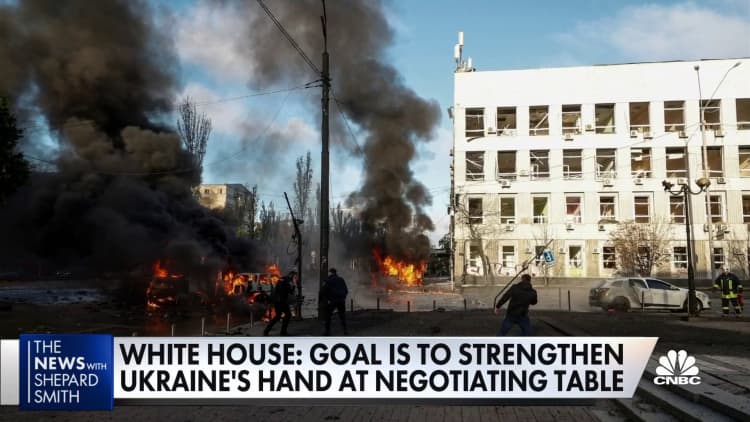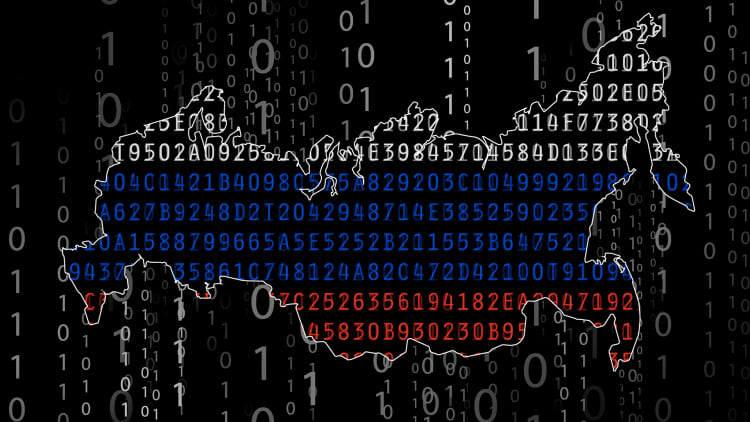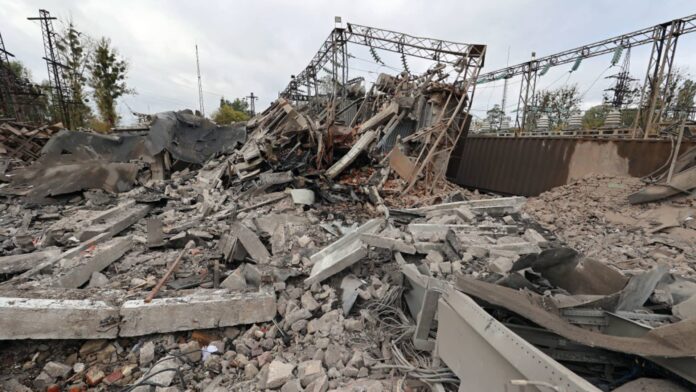A fire engine stand in front of a burning electrical substation during extinguishing a fire on September 11, 2022 in Kharkiv, Ukraine. Two people died after a rocket hit an electrical substation on the outskirts of Kharkiv. Explosions in the city rang out at 8:00 p.m. As a result of the impact of two Russian cruise missiles, the administrative building was destroyed, transformers caught fire. The entire city was completely blacked out for about four hours.
Global Images Ukraine | Getty Images News | Getty Images
Ukraine has been dealing with a spate of Russian missile attacks on its energy infrastructure this week, causing the widespread loss of water and power supplies, damaging its communications network and prompting blackouts in cities across the country.
They affected hundreds of thousands of Ukrainians and there are concerns that such attacks, and the likelihood of Russia continuing to target critical infrastructure, leaves civilians very vulnerable as winter approaches.
“The latest figures that we have is that about 30% of Ukraine’s energy infrastructure has been damaged and the government is doing everything they can to ensure that everything is quickly restored,” Yuriy Sak, an advisor to Ukraine’s Defense Minister Oleksiy Reznikov, told CNBC Wednesday.
“With the winter coming, such attacks could present grave risk to the civilian population,” he added.
Air raid sirens sounded out across multiple regions in Ukraine earlier this week with the emergency services and regional authorities having to deal with the death, damage and destruction caused by Russian strikes on Kyiv in the north, the major city of Lviv in the west, Zaporizhzhia in the south and the Donbas in the east.
The strikes by Russia were widely seen as a retaliation following a blast that damaged its prized Kerch Strait Bridge, linking the Russian mainland with Crimea (which it illegally annexed in 2014) and used to supply its troops in southern Ukraine.
Kyiv did not claim responsibility for the attack but that didn’t stop Moscow from inflicting a series of strikes on critical infrastructure and civilian targets including residential buildings, educational centers and other public spaces, despite denying it targets such locations.
During the Russian shelling on Monday alone, 10 thermal power stations and 19 electrical substations had been damaged as well as 54 residential buildings, according to Ukraine’s Minister of Communities and Territory Development Oleksii Chernyshov.
“Hundreds of thousands of Ukrainians were deprived of water, electricity and heat while the average temperature of Ukraine is around 45 degrees Fahrenheit (around 7 degrees Celsius) right now,” he said Wednesday, addressing a session of the Atlantic Council.
Since Oct. 3, he added, a total of 527 objects of critical infrastructure in the field of heat supply had been damaged as a result of Russia’s aggression. “My team and I are now working to restore the infrastructure as soon as possible … however we lack resources,” he said.
Chernyshov said that Ukraine needs four specific things to ensure Ukraine can get through these “tough times”: Mobile water treatment stations, mobile thermal power stations, diesel or gas generators and alternative fuels. The need for these things, he said “grows as we speak right now.”
Ukraine halted the export of electricity to the EU (which began in July) earlier this week and the government also called on Ukrainians to limit their energy use, particularly at peak times.
Deliberate targeting
Russia openly admits targeting Ukraine’s energy infrastructure. On Tuesday, the Russian defense ministry issued a military update on Telegram stating that its forces continue to launch “massive” attacks “using high-precision long-range air and sea-based armament at the facilities of military control and energy system of Ukraine.”
Ukraine has, unsurprisingly, slammed Russia’s targeting of energy facilities with President Volodymyr Zelenskyy saying Monday that energy facilities across the country had been hit and that Russia wanted to sow “panic and chaos.”
On Tuesday, following subsequent strikes on such facilities, Foreign Minister Dmytryo Kuleba said such acts were “war crimes planned well in advance and aimed at creating unbearable conditions for civilians — Russia’s deliberate strategy since months.”
Power substation destroyed by a Russian missile attack, Kharkiv, north-eastern Ukraine.
Future Publishing | Future Publishing | Getty Images
By Thursday this week, Ukraine’s national grid operator said that power had been almost entirely restored in the country. National energy company Ukrenergo warned that it had more work to do to properly fix supplies, however.
“The employees of Ukrenergo are dead tired but very satisfied because they restored power supply after the largest attack on the power system of an independent country in world history,” Ukrenergo said in a post on Telegram.
Ukrenegro said that Russia’s attacks were the biggest of their type in modern history. “Before World War II, there were no such advanced power grids, and after World War II there were no such large-scale military attacks targeting power infrastructure.”

The energy operator also warned that while it has been able to restore lost power supplies, “this does not mean that we have restored everything that was destroyed and damaged.”
“We have found ways to provide current, but there is still a lot of work ahead,” it warned, asking Ukrainians to consume power wisely, especially at peak times in the morning and evening.
It noted that 700 Ukrenergo energy workers in 40 repair teams are working to restore networks 24/7. “Please help them — don’t turn on too much and don’t use many electrical appliances at the same time,” it added.



